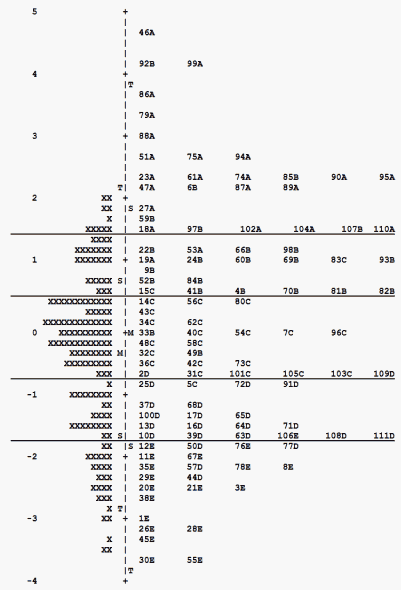
Items are written for the different levels of ability that exist in the institution. Alternatively, judges assign already written items to the existing levels of ability. In other words, they decide what ability level a person should be to answer each item. If there are say, five levels of proficiency from A to E, A being the highest and E the lowest, then the items are rated on a five point scale from 1-5. Five corresponding to the lowest level, E and 1 to the highest level, A. For instance, if the judges agree that "border line" Level B students can answer an item correctly the item is rated 2 and if they envisage that for answering the item a test-taker should be at least a border line Level A student then the item is rated 1. The average judge ratings of an item is considered as its final difficulty estimate. All the items are rated in this way.
Afterwards, the items are administered to a group of test-takers and then Rasch analyzed and the location calibrations for the items are estimated. The success and preciseness of the standard setting procedure heavily depends on the accordance between the judge-envisaged item difficulties and empirical student-based item difficulties. Any standard setting procedures in which this accordance is not achieved is futile.
If the judges have done their job properly then there must be a correspondence between the empirical item estimates and judge-based item difficulties. Figure 1 shows the item estimates hierarchy on an item-person map. The Level A items are clustered at the top of the map and the other levels' items are ordered accordingly. However, there are some items which are misplaced. It is obvious that judge-intended levels of the items never correspond exactly with the Rasch measures. For instance, as can be seen in Figure 1, Rasch has reported some A items down in the B region (or below) and some B items up in the A region (or above).
Standard-setting always requires a compromise between the judges' item hierarchy and the empirical (Rasch) item hierarchy which corresponds to actual examinee performance. Standard-setting also requires negotiation about the location of the criterion levels. There will be several reasonable positions for the criterion level, from least-demanding to most demanding.
We might choose the transition points to be the lines at which the minimum number of items are misclassified between two adjacent levels. For example, the transition point between Level A and Level B is the point where the items predominantly become Level B items (as is done in Figure 1). That is, the difficulty level of item 18A or 97B which is 1.53 logits.
Or we might choose the line corresponding to 60% chances of success on the items that fall in the transition points determined by the procedure above. For example, the items at the transition points between Level A and Level B have a difficulty estimate of 1.53 logits. This is an item of borderline difficulty. In other words, an ability estimate of 1.53 logits can be the minimum cut-off score for Level A. This is the ability level required to have 50% chances of getting this item right. To be on a safe side, one can also define:
"cut-off score" = 60% chances of success on an item of borderline difficulty
Therefore, the cut-off score for Level A will be:
Pni (Xni=1| θn, δi) = exp(θn - δi) / (1 + exp(θn - δi))
0.60 = exp(θn - 1.53) / (1 + exp(θn - 1.53))
loge(1.5) = θn - 1.53
θn = 1.93
The cut-off scores for the other levels can be determined in a similar way. The items at the point of transition between Level B and Level C are 15C, 41B, 4B, 70B, 81B, 82B with difficulty estimates of 0.68 logits. Therefore the cut-off score for Level B can either be 0.68 logits, if we consider the 50% chances of success on the items at the transition point, or 1.08 logits if we consider 60% chances of success at the transition point.

Figure 1: Difficulty order of items and their judge-based corresponding levels
Baghaei P. (2009) A Rasch-Informed Standard Setting Procedure, Rasch Measurement Transactions, 2009, 23:2, 1214
| Forum | Rasch Measurement Forum to discuss any Rasch-related topic |
Go to Top of Page
Go to index of all Rasch Measurement Transactions
AERA members: Join the Rasch Measurement SIG and receive the printed version of RMT
Some back issues of RMT are available as bound volumes
Subscribe to Journal of Applied Measurement
Go to Institute for Objective Measurement Home Page. The Rasch Measurement SIG (AERA) thanks the Institute for Objective Measurement for inviting the publication of Rasch Measurement Transactions on the Institute's website, www.rasch.org.
| Coming Rasch-related Events | |
|---|---|
| Jan. 16 - Feb. 13, 2025, Fri.-Fri. | On-line workshop: Rasch Measurement - Core Topics (E. Smith, Winsteps), www.statistics.com |
| Apr. 8 - Apr. 11, 2026, Wed.-Sat. | National Council for Measurement in Education - Los Angeles, CA, ncme.org/events/2026-annual-meeting |
| Apr. 8 - Apr. 12, 2026, Wed.-Sun. | American Educational Research Association - Los Angeles, CA, www.aera.net/AERA2026 |
| May. 15 - June 12, 2026, Fri.-Fri. | On-line workshop: Rasch Measurement - Core Topics (E. Smith, Winsteps), www.statistics.com |
| June 19 - July 25, 2026, Fri.-Sat. | On-line workshop: Rasch Measurement - Further Topics (E. Smith, Winsteps), www.statistics.com |
The URL of this page is www.rasch.org/rmt/rmt232f.htm
Website: www.rasch.org/rmt/contents.htm